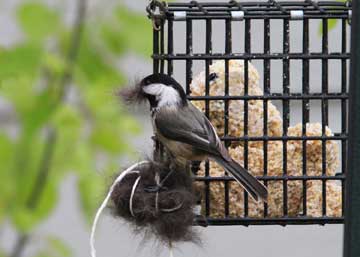 |
Previous Issues |
| Cedar Mill Community Website |
|
| Search the Cedar Mill News: | About The Cedar Mill News |
|
|||||||
| Volume 8, Issue 7 | July 2010 |
||||||
The Nature of Cedar Mill
|
 |
One of the chickadee parents collects cat hair to build its nest. Photos by Jeff Young. |
One of our most common Cedar Mill cavity-nesting species is the Black-capped chickadee. Their songs and calls are part of our background “noise” in this area since they are numerous. Sometimes they use abandoned woodpecker holes in snags but most of us, unlike the birds, are not too enamored of dead trees, so gardeners tend to cut down old snags in our yards. So these birds will use birdhouses that we find more decorative and they find acceptable. It is a treat to see them learn to fly and learn to pick the aphids off my roses (which I don’t spray for that very reason—free bird food!)
Last year I bought a ball of woolen material from a local pet store that was sold as “nesting material.” Indeed the Goldfinches and Chickadees and other birds picked off bits and took the material to line the nests. This year I could not find such an item so being a good recycler I improvised and used CAT HAIR from brushing my indoor cats (who love to watch the birds out the window at the feeders, so this seemed like a good mutual sharing). Well lo and behold the birds enthusiastically embraced the recycling idea as you can see from the picture my husband captured of a chickadee collecting cat hair attached to the suet feeder!
 The baby Chickadee who emerged was nurtured with cat hair as his baby mattress. He or she was so adorable minutes after emerging from the bird house and we got so close before the parents came up and shooed the little one into the shrubbery away from prying cameras (and of course lurking Cooper’s hawks and outdoor cats).
The baby Chickadee who emerged was nurtured with cat hair as his baby mattress. He or she was so adorable minutes after emerging from the bird house and we got so close before the parents came up and shooed the little one into the shrubbery away from prying cameras (and of course lurking Cooper’s hawks and outdoor cats).
Reportedly at one time the Tualatin Valley had Bluebirds, another cavity nesting species, whose habitat was taken over by Starlings and House sparrows. There are still Bluebirds at locations further south such as Tualatin National Wildlife Refuge.
Degradation of habitat is a problem for many ground nesters such as the Western meadowlark which is our state bird—this bird’s habitat has been reduced for years and their number has declined. Many “beach “birds such as the Plovers also nest on the ground and the intrusion of people, dogs and cars have impacted their ability to produce young who survive.
So the next time you see a Killdeer or Quail family, celebrate the hedgerows, the marshes and the places where we don’t tromp on the young of these wonderful birds!! The amazing number of foods that birds eat, places they nest and songs they sing points to the many ways we can all take advantage of the bounty of nature if we are flexible.
Lauretta Young is a retired physician who now teaches community health at PSU and management for healthcare at OHSU and leads private customized bird tours in Cedar Mill and the metro area—check out her web site for more pictures and blogs at www.portlandbirdwatching.com
Published monthly by Cedar Mill Advertising & Design
Publisher/Editor:Virginia Bruce
503-629-5799
PO Box 91061
Portland, Oregon 97291